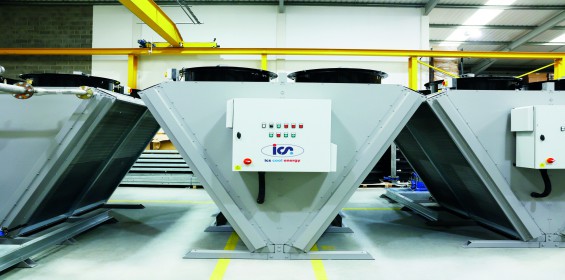Standalone Vs integrated: How to decide on the best free cooling route
Published: 26 March, 2019
Richard Metcalfe, director (UK & Ireland sales & service) at ICS Cool Energy, breaks down the pros and cons of the two most popular types of free cooling systems.
Free cooling is a fast, effective and economical way for industrial end-users to reduce their process cooling energy costs, in some cases by up to 80%. However, accurate specification is key to unlocking its true potential – get it right and the system can pay for itself within 18 months, but get it wrong and the investment may fail to live up to expectations.
Suitable for all industrial applications with a water leaving temperature of 10°C or more, free coolingcan be achieved as soon as the ambient air temperature drops below the process fluid return temperature. When this happens, a 3-way valve diverts the returning process fluid through the free cooling unit, where the cooler ambient air removes some of the process heat, subsequently cooling the returning fluid.
As such, free cooling is a tangible, sustainable and cost-effective way of reducing a site’s process cooling operation costs. However, maximum efficiency can only be achieved by accurate specification.
Free cooling systems are typically available in two forms, either as a standalone unit where the chiller works in series with an independent free cooling unit, or by integrating a free cooling coil into an existing chiller installation. However, they are by no means interchangeable and opting for the wrong solution can significantly impact system efficiency and long-term ROI.
Standalone free cooling
A standalone free cooling system sees an independent free cooling unit working alongside a chiller. From a cap-ex perspective, the start-up costs are comparatively lower for a standalone system as end-users can partner the free cooling unit with their existing chiller.
One of the key requirements to maximise the ROI of a standalone system is ability for it to be externally-sited. As the system comprises of at least two units, it requires a greater amount of space given the footprint of the equipment, and the subsequent need to allow air to circulate around the units.
However, the increased footprint means a larger surface area, which can allow better part loading to be achieved – akin to up to an 80% saving on running costs a year. What’s more, standalone free coolingsystems have the capacity to provide 100% free cooling at a higher ambient air temperature than integrated free cooling chillers.
Integrated free cooling
For sites which may not have the available space to accommodate standalone units, such as those located within urban environments or where free cooling is being considered as part of a retrofit project, an integrated free cooling unit may be the most viable option.
Integrated systems are also an excellent choice for high capacity systems with limited available footprint, as a standalone system on that scale would require significant floorspace to accommodate the necessary equipment.
However, to caveat for the smaller unit size, in order for an integrated system to achieve 100% free cooling, the ambient air temperature needs to be lower; usually in the region of 2°C, compared to 5°C for standalone systems.
Don’t take funding for granted
Crucially, both standalone and integrated free cooling systems qualify for a number of financial incentives which industrial end-users should take advantage of. Both types of system are listed on the Energy Technologies List (ETL), which means companies can receive accelerated tax relief via the Enhanced Capital Allowances (ECA) scheme. SME end-users may also be eligible to receive grant funding of up to £5,000 through schemes such as the Carbon Trust’s Green Business Fund.
Final thoughts
Ultimately, free cooling can deliver achievable, long-term energy savings which can translate into a significant reduction in monthly utility costs. However, ensuring the right type of system is specified is key to unlocking its energy saving potential. For end-users keen to explore the potential free cooling has to offer, I would urge you to get in touch with your temperature control provider today to find out more.
For further information please visit: www.icscoolenergy.com







